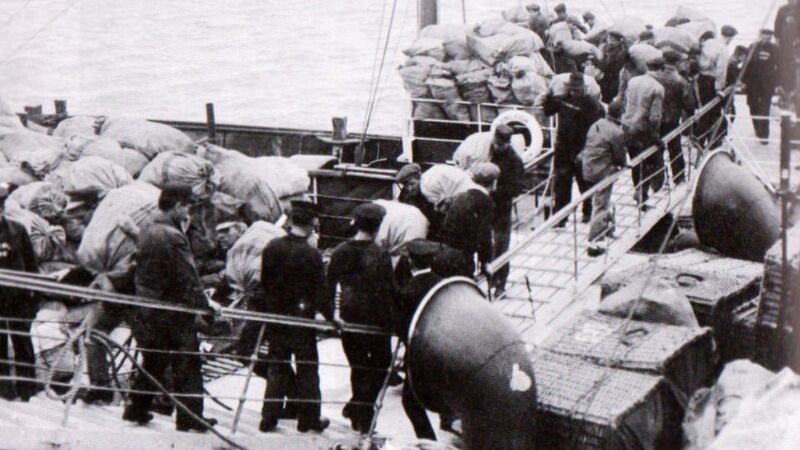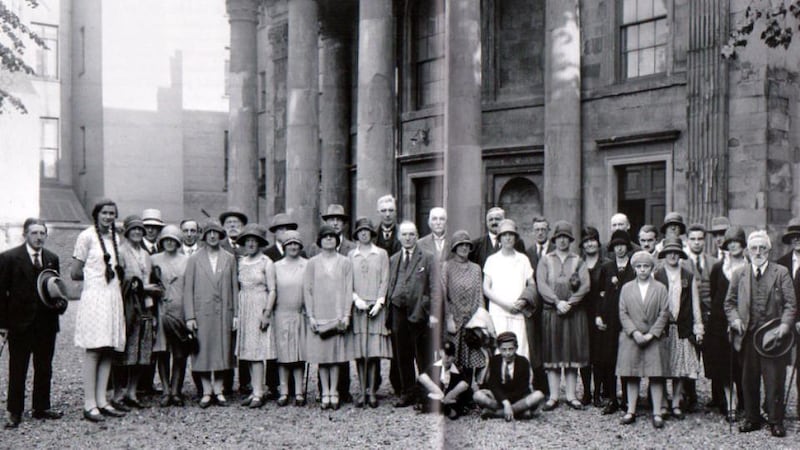Few institutions in Ireland can claim such an influential pedigree as the Post Office, whose 300-year history is inextricably linked to the changing face of Irish life. In The Post Office in Ireland: An Illustrated History (Irish Academic Press, €26.99) Stephen Ferguson draws on unpublished material, discovering a wealth of images such as mail coaches, Penny Black stamps, and the days when a whistle was carried by rural postmen announcing their arrival in remote villages.
An intriguing chapter looks at the Travelling Post Office (TPO), a purpose-built carriage that first ran on the Dublin-Cork nightmail of the Great Southern and Western Railway on January 1st, 1855. The service operated all over the country and was severed when the last TPO was withdrawn in 1994.
Most post was – and still is – delivered safely, but an evocative black-and-white photograph in 1912 by Fr Francis Browne shows mailbags being picked up at Queenstown (now Cobh) and conveyed from a tender on to the ill-fated RMS Titanic – never to reach its ultimate destination.

A comprehensive account of the organisation’s past, this is a heavy volume of 450 pages; while it is well worth the weight of its research, we should perhaps take pity on today’s postie having to deliver it through a letterbox.
Another large tome, lavishly illustrated with 600 colour images, is Architects of Ulster: Young & MacKenzie, A Transformational Provincial Practice, 1850-1960 (Ulster Architectural Heritage Society, £28) by Paul Harron, an architectural historian. He documents the work of a vibrant firm formed in the early 1850s which survived for three generations and popularised Gothic Revivalism for Presbyterians. The firm designed numerous structures in Belfast such as the Ocean Buildings, Scottish Provident, and the Presbyterian Assembly Buildings, as well as the much-missed department stores Robinson & Cleaver, and Anderson & McAuley whose buildings have been repurposed.
The book delves into the life of the families running the firm. Robert Young was the founder and became an Irish Privy councillor; his son, Robert Magill Young, who was born in Athlone, was a historian. Aside from the commercial and industrial aspect, ecclesiastical buildings give rise to the chapter title “Architects of Presbyterianism (And very occasionally others)” covering not just the North, but churches in Carlingford, Dunfanaghy and Ramelton.
One of Belfast's best-known churches, St George's, is not included because its founding stretches back to 1816, more than 30 years before the company was established, although there had been Christian worship on the site for many centuries. Its absorbing story is recounted in A History of St George's Church Belfast (Ulster Historical Foundation, £19.99) by Brian Walker.
The church has played an important role in the spiritual and cultural development of the city and has survived many physical threats of destruction including the 1941 Blitz in the second World War. During one year of the Troubles, 1972, it was damaged no fewer than nine times in bomb blasts.
The services in St George’s are regarded as High Anglican. Its musical reputation dates to the appointment as organist in 1817 of Edward Bunting, the collector of Irish airs. Bunting had participated in the famous harp festival in Belfast in 1792 and his collection of 66 harp melodies was published in 1797. Rare engravings, paintings and early photographs are among the range of illustrations. An impressive two-page photographic spread features 40 well-attired gentlemen, ladies and junior members of the venerable Belfast Naturalists’ Field Club enjoying an outing to the church in 1929.

The architectural history of another church and its adjoining graveyard is examined in Heart and Soul: A History of Saint Brendan's Graveyard in Birr (Offaly County Council, €20) by Stephen Callaghan and Caimin O'Brien.
St Brendan’s is a pre-Reformation church, and burial plots are at least 800 years old but only 156 memorials, mostly from the early 18th to the late 19th century, are legible. The authors have recorded, photographed and tabulated the memorials and decorative emblems of faith. Delicately carved gravestone artwork includes spirals, rosettes, winged heads, three-leafed clover, and hourglasses representing the passage of time. The individual details of the elaborate stone carvings are a testimony to the unique work that allowed masons to demonstrate their artistic imagination. The authors also explain the use of rubric, the opening sentiment on a headstone, such as “Here lyeth . . .” or “Pray for the soul of . . .”.
Due to overcrowding, the graveyard closed to new burials in 1879, by which stage geese and lambs were grazing in the grounds. St Brendan’s remains a place of geographical, social and sacred history, a physical link between the town and the past when Birr was called Parsonstown. This handsomely illustrated hardback ensures that the religious and folk art of its talented craftsmen will not be forgotten.
Paul Clements is the author of Wandering Ireland's Wild Atlantic Way, published by the Collins Press
















